Spouse Mah Banu Begum Name Abdul Khan-I-Khana House Jalairid Sultanate | Issue Jana BegumTwo sons Role Poet | |
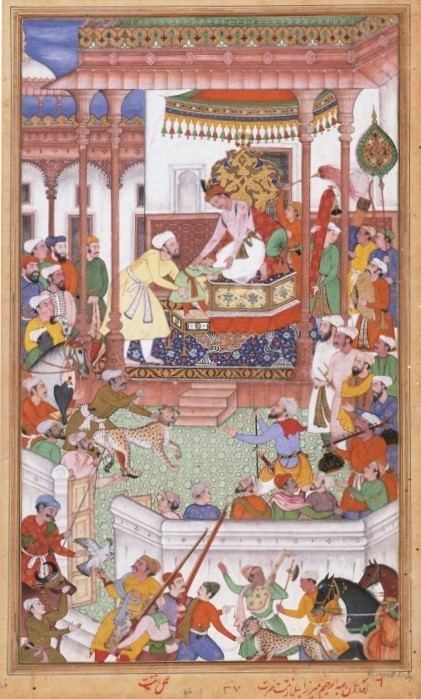 | ||
Buried 1627, Tomb of Abdul Rahim Khankhana Similar People | ||
Tomb of abdul rahim khan i khana nizamuddin delhi
Khanzada Mirza Khan Abdul Rahim Khan-e-Khana (17 December 1556 – 1627) (Urdu: عبدالرحيم خان خانان), also known as Rahim (رحیم) was a poet who lived during the rule of Mughal emperor Akbar. He was one of the nine important ministers (dewan) in his court, also known as the Navaratnas. Rahim is known for his Urdu couplets and his books on astrology. The village of Khan Khana, which is named after him, is located in the Nawanshahr district of the state of Punjab, India.
Contents
- Tomb of abdul rahim khan i khana nizamuddin delhi
- Tomb of abdul rahim khan i khana one of the nine ministers of emperor akbar
- Biography
- Major works
- Tomb of Abdul Rahim Khankhana
- References

Tomb of abdul rahim khan i khana one of the nine ministers of emperor akbar
Biography
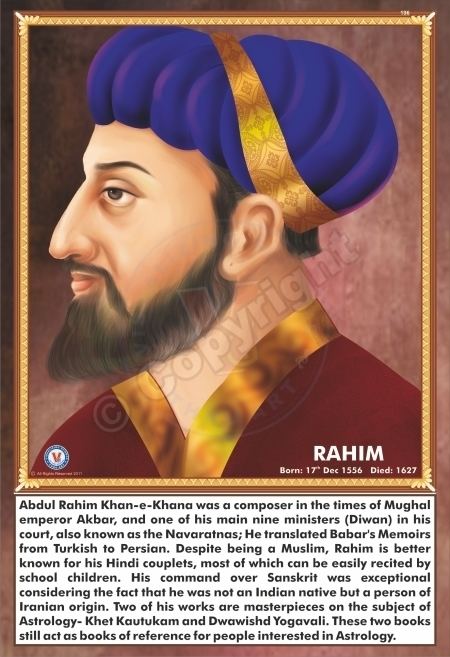
Abdul Rahim was the son of Bairam Khan, Akbar's trusted guardian and mentor, who was of Turkic ancestry. When Humayun returned to India from his exile, he asked his nobles to forge matrimonial alliances with various zamindars and feudal lords across the nation. Humayun married the elder daughter of Jamal Khan of Mewat (present Mewat district of Haryana) and he asked Bairam Khan to marry the younger daughter.
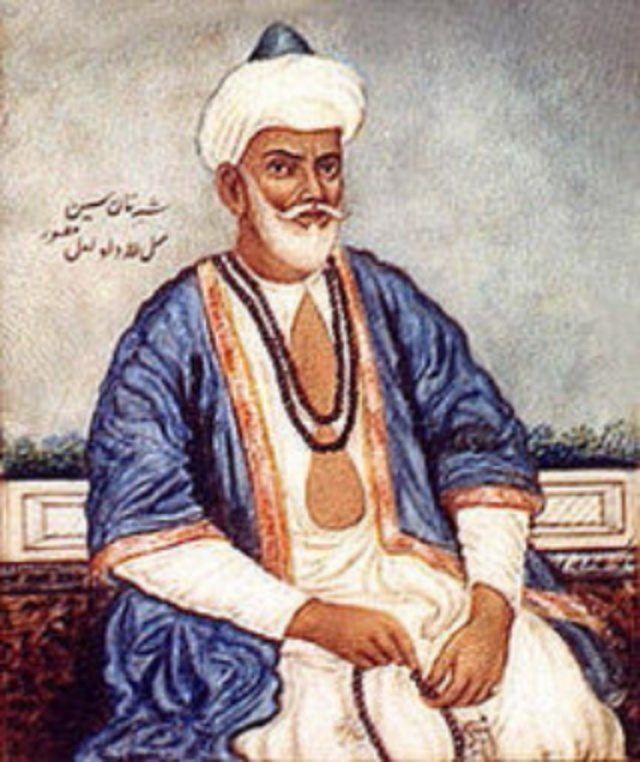
Gazetteer of Ulwur (Alwar) states:
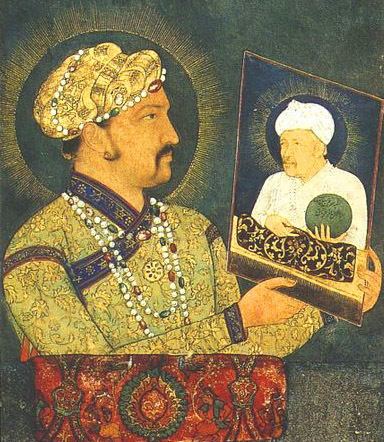
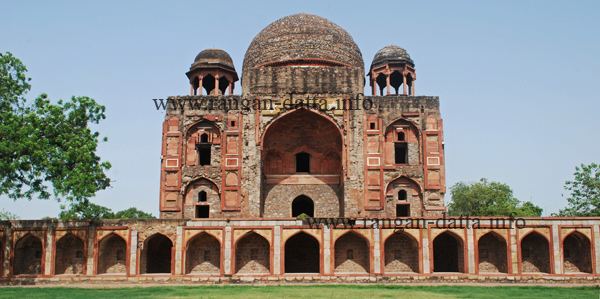
Khanzadahs, the royal family of Muslim Jadon (also spelt as Jadaun) Rajputs, accepted Islam on their association with the Sufi saints. Khanzadah, the Persian form of the Sanskrit word 'Rajput'. Khanzadas were believed to have converted from a Branch of Hindu Rajputs. They were the Mewatti Chiefs of the Persian historians, who were the representatives of the ancient Lords of Mewat.
Khanzadah, or "the son of a Khan" is precisely the Musalman equivalent to the Hindu Rajput or "son of a Raja " ...
Abdul Rahim was born in Lahore (now in Pakistan) to Bairam Khan and the daughter of Jamal Khan of Mewat of modern-day Haryana.
After Bairam Khan was murdered in Patan, Gujarat, his first wife and young Rahim were brought safely from Delhi to Ahmedabad and presented at the royal court of Akbar, who gave him the title of 'Mirza Khan', and subsequently married him to Mah Banu(MoonLady)sister of Mirza Aziz Kokah, son of Ataga Khan, a noted Mughal noble.
Later, Bairam Khan's second wife, Salima Sultan Begum (Rahim's stepmother) married her cousin, Akbar, which made Abdul Rahim Khan-e-Khan also his stepson, and later he became one of his nine prominent ministers, the Navaratnas, or nine gems.
An incident in his life, where his womenfolk were protected and safely returned by Rana Pratap made Rahim Khan, a Muslim by birth, a devotee of Krishna and wrote poetry dedicated to him.
Abdul Rahim was known for his strange manner of giving alms to the poor. He never looked at the person he was giving alms to, keeping his gaze downwards in all humility. When Tulsidas heard about Rahim's behaviour when giving alms, he promptly wrote a couplet and sent it to Rahim:-
"ऐसी देनी देंन ज्यूँ, कित सीखे हो सैन
ज्यों ज्यों कर ऊंच्यो करो, त्यों त्यों निचे नैन"
"Why give alms like this? Where did you learn that? Your hands are as high as your eyes are low"
Realizing that Tulsidas was well aware of the reasons behind his actions, and was merely giving him an opportunity to say a few lines in reply, he wrote to Tulsidas saying:-
"देनहार कोई और है, भेजत जो दिन रैन
लोग भरम हम पर करे, तासो निचे नैन"
"The Giver is someone else, giving day and night. But the world gives me the credit, so I lower my eyes."
His two sons were killed by Akbar's son Jehangir because they were not in favour of Jehangir's accession to the throne at Akbar's death.
He is considered a Persophile.
Major works
Apart from writing various dohas, Rahim translated Babar's memoirs, Baburnama from Chagatai language to Persian language, which was completed in 998 (1589–90) AD. He had an excellent command over Sanskrit.
In Sanskrit, he wrote two books on astrology, Khetakautukam (Devanagari: खेटकौतुकम्) and Dwatrimshadyogavali (Devanagari: द्वात्रिंशद्योगावली).
Tomb of Abdul Rahim Khankhana
His tomb is situated in Nizamuddin East on the Mathura road near Humayun's Tomb in New Delhi. It was built by him for his wife in 1598, and his body was placed in it in 1627. In 1753-4, marble and sandstone from this tomb was used in the construction of Safdarjung's Tomb, also in New Delhi.
New Delhi, Nov 4, 2014 (IANS) InterGlobe Foundation and the Aga Khan Trust for Culture (AKTC) Tuesday announced they would collaborate to conserve and restore Abdul Rahim Khan-i-Khanan's tomb in the capital.
Popularly known as Rahim and immortalised through his dohas's or couplets, Rahim was amongst the most important ministers in Akbar's court. He was one of the Navratnas and continued to serve Salim after his accession to the throne as Emperor Jahangir.
The tomb sits prominently along the Mathura Road, formerly the Mughal Grand Trunk Road, and is in close proximity to the Dargah of Hazrat Nizamuddin Auliya and Humayun's Tomb in South Delhi.
